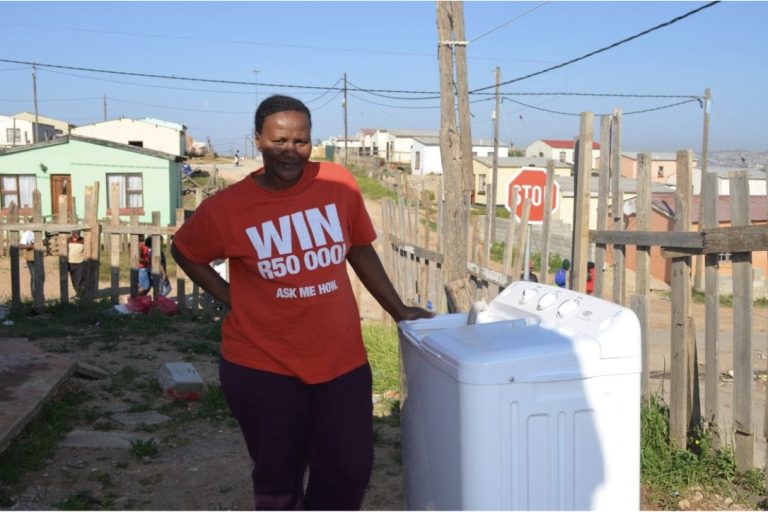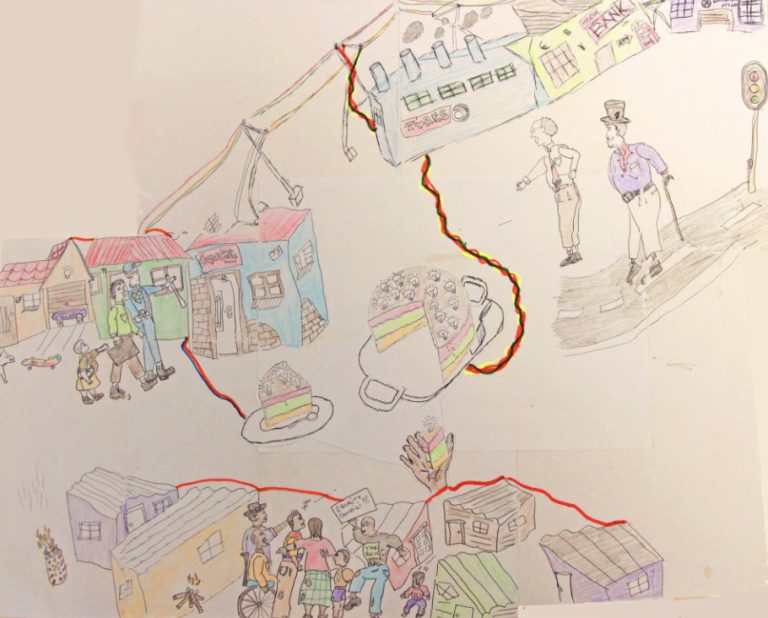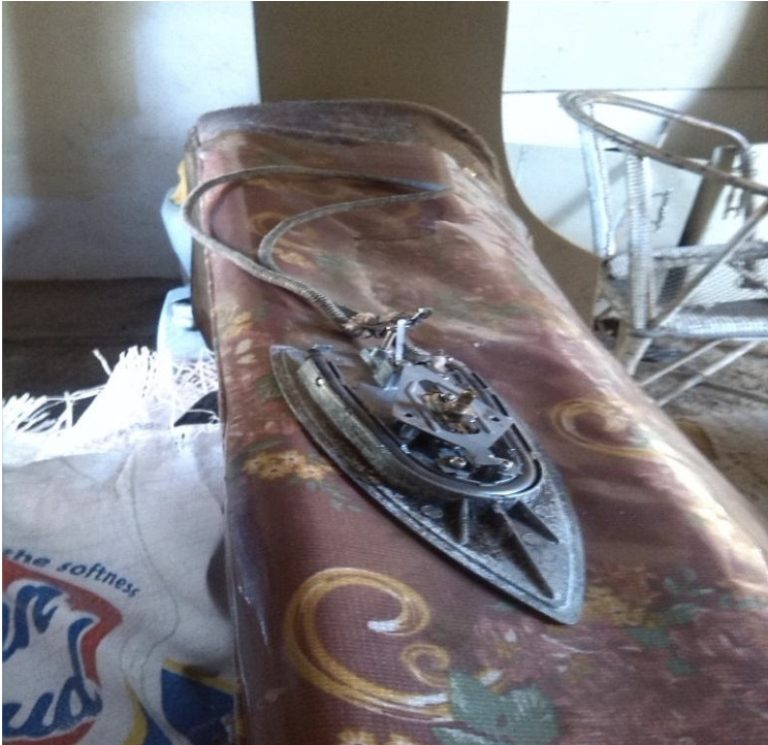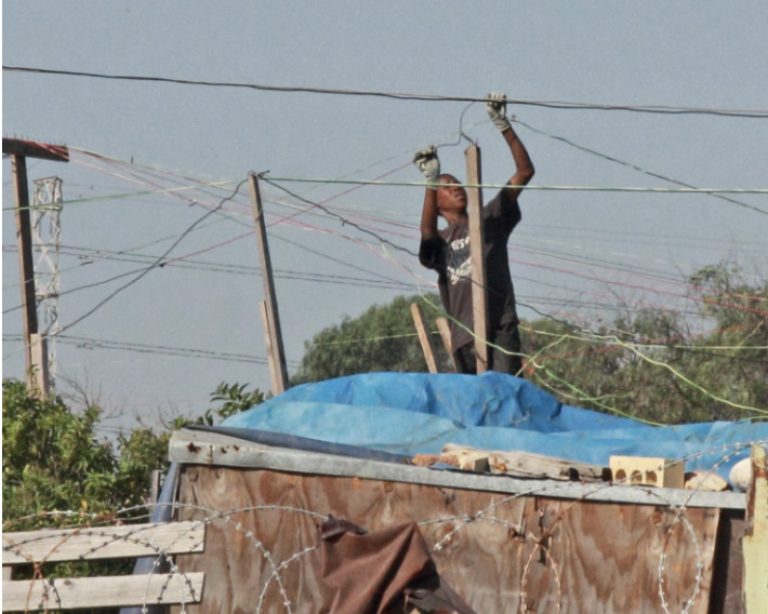‘Behind the Wires’ - Photo stories and social change
5 March 2021 | Thalia Eccles Innovative Practice
At the Mass Education Event I walk with a man through the poster exhibition, and we look at the pictures that so starkly represent the community in which he lives. We stop at the photo-posters about shack fires caused by unauthorized electricity connections and he tells me of the shack fires that happen every year and how this situation needs to change.
This conversation amidst the organized education activities that form part of Mass Education Events, was one of many between the Community Education Programme team and community members. The Mass Education Events, held in two communities in Port Elizabeth in July and September 2014, included an exhibition of more than 30 posters, practical workshops and a piece of popular theatre. On the surface the posters focuses around the issues of energy and unauthorized electricity connections found in the communities of Chris Hani, Rholihlahla and Soweto-on-Sea, but ‘Behind the Wires’ they shout about a need for social change.
These posters were written by four of the 28 Community Investigators, who form the Community Education Programme (CEP) hosted by the Centre for Integrated Post-School Education and Training (CIPSET) and are part of a participatory curriculum which we are making. Within the setting of the Mass Education Events, the posters are codes that enable exploration of social issues, histories and narratives and the beginning of dialogue around inequality and progressive possibilities. Within the CEP they form the documentation of our community based participatory action research and the culmination of various discussions on environmental injustice, social change and the purpose of adult education. They are the embodiment of some of the principles on which we have based the CEP:
- “Kufuneka imibono emanyanayo kulwazi. Ukusebenzisa nokuhlonipha ulwazi oluvela kwabadala, abantwana, abafundi, abefundisi-ntsapho, izithwala-ndwe, abazali nemibutho yasekuhlaleni. -There should be an integrated approach to knowledge. Using and respecting knowledge from adults, children, learners, educators, academics, parents and community organisations.
- Abaphandi: sonke singabaphandi-siyakwazi ukuphanda siza ngezinto ezibalulekileyo kuthi. –Researchers: we are all researchers – we can all investigate and create knowledge about things that are important to us.” (Community Education Programme, 2014, p. 8)
Sanna Hector’s Story, written by Andiswa Matiwane, is a good example of how the academic tool of a research interview can be used to share a personal narrative. It is also a good example of how community research can not only give a ‘face’ and a qualitative perspective on an issue, but help demonstrate the democratic principle of popular education: that everyone’s voice counts.
The Electricity Cake was written and illustrated by Mzimkhulu Keye. It deals with the complexity of power relationships in the energy industry. It also shows us the power of creativity in community education. Mzimkhulu is a keen artist who has found space for expression that helps build collective knowledge of key social issues. Using art makes social dialogue about complex issues easier.
The MacGyver, written by Nomvula Kato and Xola Masela, tells the story of practical solutions. It also shows one of the dangers of electricity use whilst highlighting the great need for practical knowledge of electricity to overcome those dangers. The Mass Education Events included a practical workshop on electricity run by the CEP community educators. The practical workshops introduced a safe opportunity to experiment with electricity and gain conceptual knowledge with which to interrogate community circumstances.
Mr Fix it, written by Vusumzi Meta, helps us to see the links between our history, service delivery, livelihoods and energy. One of the exciting things we see in community education are those moments when conceptual connections are made between personal narratives and structural issues. Those moments help us to dig into and examine the narratives that oppress us and to make new ones that give us hope and agency.
Bibliography
Community Education Programme. (2014). Community Education Manifesto. Port Elizabeth: Centre for Integrated Post-school Education and Training, Nelson Mandela Metropolitan University.
1 ‘Behind the Wires’ was the name of the Mass Education Event hosted by the Community Education Programme. This event wants to show how electricity connects with people and is both helpful and dangerous. It reveals how our access to and use of energy resources also reflect the inequality in the way our society is organised. Through the event the CEP wanted to open a participatory and democratic space for education and dialogue around what exists now, but also to start an exploration of progressive possibilities and alternatives.
Sanna Hector’s Story
Sanna Hector stays in Rholihlahla and she is not using illegal connections, she stays in an RDP house.

She says that some people are using illegal connections simply because they are unemployed and some have children who they have to look after.
Some people are in danger and others are being killed by the electrical wires. “Electricity is very dangerous here in Rholihlahla. There was a house that burned down three months ago due to an illegal connection. These connections will only bring death in this community.”
Many people are poor and they are paying a lot of money – R200 per month - to the people who live in RDP houses, and who make a living from the illegal connections that they are doing. Sometimes there are up to 20 connections from one RDP house.
People beg for houses so that they can live better lives like others, so that they can be equal, all together.
This story was written by Andiswa Matiwane
Cutting the Electricity Cake
Multi-national corporations use the most electricity. They use electricity 24 hours non-stop to produce goods and maximise profit for the capitalist class. Communities do not benefit from these profits. Companies’ profit goes to the investors and their shareholders and not to new jobs. Government should have taxed them for their high usage of energy; instead they offer the subsidy on electricity costs.

Households all pay the same for electricity. But, middle class people work and have decent houses. They can pay for electricity for many different appliances.
People need RDP houses to get access to electricity. Energy costs for working class people make up a big part of their living costs. The government helps people who are unemployed with the cost of a small amount of energy – this is often not enough. Working class people who live in informal houses make means to join the modern age when they connect illegally.
This story and drawings are by Mzimkhlulu Keye
The Macgyver
In Govan Mbeki there are two guys who are unemployed, as a result they do not have money to buy electricity. They decided to put a needle in the electricity box in order to survive. In the box the electricity is at zero even though the electricity is running.

They have a macgyver stove and iron. The iron has no handle, and they take the wires of the iron and connect them in the box, until the iron gets warm. When the iron is warm they take the wires out of the box and continue ironing.
In most of the areas in Govan Mbeki wires are crossed up from house to house, this is dangerous for people. Cables are lying on the ground which is dangerous for kids and for everyone when it rains.
People are using illegal connections, because the unemployment rate is so high and there is poor service delivery in their community.
This story was written by Nomvula Kato and Xola Masela
Who is Mr Fix-It?
Our society managed to have a smooth transition from apartheid to a constitutional democracy in 1994. But in the 22 years of democracy our communities still experience social inequalities which continue to divide and isolate people. This is experienced by Thamsanqa. His story is common in South African townships.

Thamsanqa is a young man who has been living in Chris Hani informal settlement for 22 years, with no electricity sanitation, water or means to make a livelihood. Thamsanqa also feels the need to make means to survive. He sees everyone around him making plans to make a living.
Thamsanqa is a drop-out from school. There were many challenges he had to face in his home. As a result of unemployment in at home, he became Mr Fix-it; making illegal connections in order to survive.
Electricity has affected the relations between people living in the same area. RDP houses can make a livelihood from illegal connections to the shacks. And struggling young people can make a living.
This story was written by Vusumzi Metha